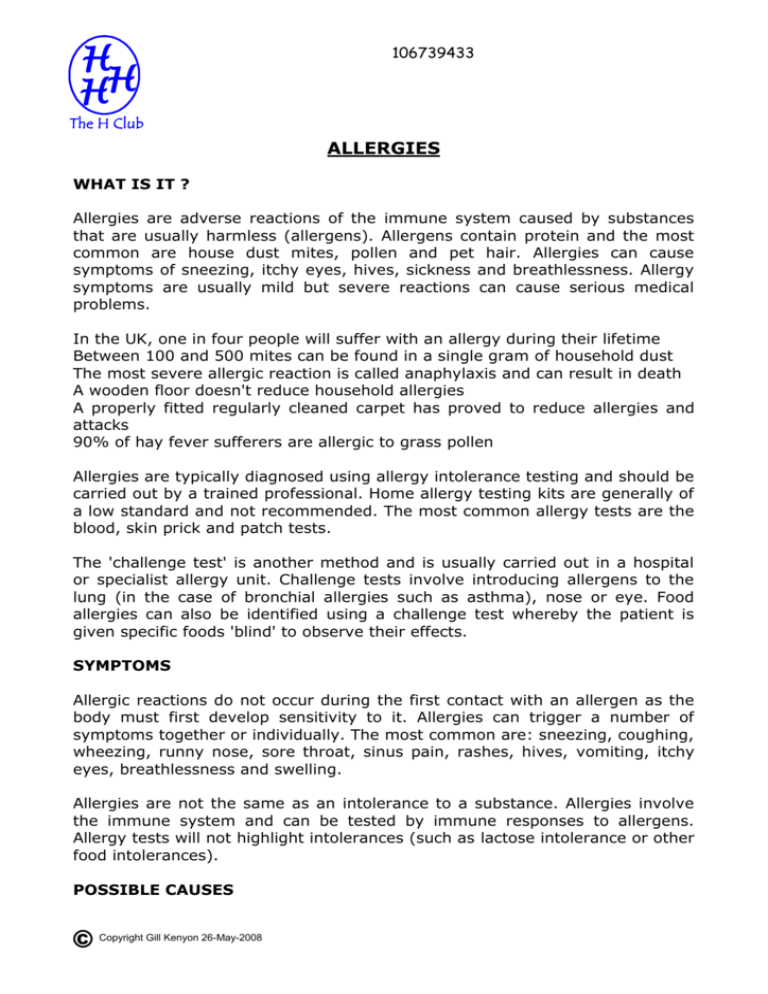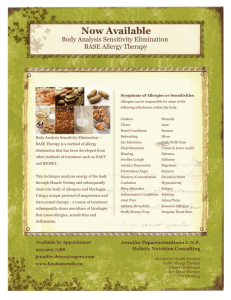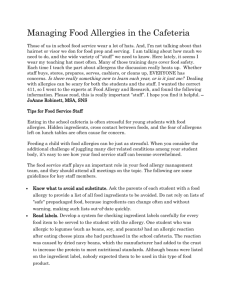Allergies - The H Club
advertisement

H HH 106739433 The H Club ALLERGIES WHAT IS IT ? Allergies are adverse reactions of the immune system caused by substances that are usually harmless (allergens). Allergens contain protein and the most common are house dust mites, pollen and pet hair. Allergies can cause symptoms of sneezing, itchy eyes, hives, sickness and breathlessness. Allergy symptoms are usually mild but severe reactions can cause serious medical problems. In the UK, one in four people will suffer with an allergy during their lifetime Between 100 and 500 mites can be found in a single gram of household dust The most severe allergic reaction is called anaphylaxis and can result in death A wooden floor doesn't reduce household allergies A properly fitted regularly cleaned carpet has proved to reduce allergies and attacks 90% of hay fever sufferers are allergic to grass pollen Allergies are typically diagnosed using allergy intolerance testing and should be carried out by a trained professional. Home allergy testing kits are generally of a low standard and not recommended. The most common allergy tests are the blood, skin prick and patch tests. The 'challenge test' is another method and is usually carried out in a hospital or specialist allergy unit. Challenge tests involve introducing allergens to the lung (in the case of bronchial allergies such as asthma), nose or eye. Food allergies can also be identified using a challenge test whereby the patient is given specific foods 'blind' to observe their effects. SYMPTOMS Allergic reactions do not occur during the first contact with an allergen as the body must first develop sensitivity to it. Allergies can trigger a number of symptoms together or individually. The most common are: sneezing, coughing, wheezing, runny nose, sore throat, sinus pain, rashes, hives, vomiting, itchy eyes, breathlessness and swelling. Allergies are not the same as an intolerance to a substance. Allergies involve the immune system and can be tested by immune responses to allergens. Allergy tests will not highlight intolerances (such as lactose intolerance or other food intolerances). POSSIBLE CAUSES C Copyright Gill Kenyon 26-May-2008 H HH 106739433 The H Club Allergies occur when the body comes into contact with a harmless substance (an allergen) that it believes is invading it resulting in a hypersensitive reaction. The immune system releases the immunoglobulin E antibody (IgE) to defend the body which in turn releases other chemicals. These chemicals, one of which is histamine, combine to cause symptoms of irritation and inflammation. If a person has a food allergy, the antibody IgG is released. People can be predisposed to allergens due to family history and their condition is called Atopy. Atopy means the individual's body produces higher levels of the IgE antibody. Environmental factors can increase the chances of atopy if a child grows up in house of smokers, pets, excessive dust mites or if they are taking antibiotics. There are thousands of allergens including dust mites, pollen, animal fur, grass, insects, milk, eggs, peanuts, tree nuts, fruit, latex and certain medications (penicillin, aspirin, codeine). RELATED TERMS Allergic Reaction Scratching Redness Itching, Itchy Skin Weal Hives Hay fever Poolen Organisms Blood cells Sensitive Sensitivity Allergy management Antihistamines Invading Multiple Chemical Sensitivity REPUTEDLY HELPFUL THERAPIES The therapies and treatments reputed to be beneficial when used by people with this condition include: Acupuncture, Allergy Intolerance Testing, Aromatherapy, Ayurvedic Medicine, Bowen Therapy, Chinese Herbal Medicine, Colonic Hydrotherapy, Detoxification, Ear Candling, EFT, Energy Healing, Herbal Medicine, Homeopathy, Hypnotherapy, Kinesiology, Naturopathy, Nutrition, Reflexology, Reiki C Copyright Gill Kenyon 26-May-2008 H HH 106739433 The H Club SELF HELP This area has yet to be updated GENERAL It is advisable to choose a technique and practitioner who is a member of, or is accredited by, an association or professional body. This ensures your treatment or session is carried out in a suitable environment and by someone who has received formal training and ongoing development. Members are also bound to a code of ethics and practice. The main organisations are listed under each technique in the Therapies infobase. Your practitioner should always spend time during your first appointment questioning you about your medical history and general health. From this consultation they can decide what techniques are best to treat your condition. At subsequent sessions, there should always be a review period and check that your on-going physical and mental health has not become contra-indicative in relation to the session you have chosen It is advisable not to drink alcohol on the day of your appointment, drink plenty of water instead. Allow plenty of time to get to your appointment; hurrying will affect your physical and mental well-being and be detrimental to the effects of the therapy. Have a light meal (nothing spicy or fatty) a couple of hours before you see any practitioner for a physical therapy and avoid any activity that requires too much exertion. Wear loose, comfortable clothing Be aware that you’re a physical therapy session may require the practitioner to be hands-on and you may need to be fully or partially undressed during the treatment. In this case, your practitioner should provide you with a towel, robe or blanket. CONTRAINDICATIONS If under medical or psychological supervision or taking prescribed medication, all clients are best advised to verify in advance that their medical or psychological adviser has no objections to them receiving or utilising the above techniques. Most insurance companies would expect practitioners to take due note of the any partial or total contra-indications and, where appropriate, only give treatments subject to medical or psychological adviser permission. C Copyright Gill Kenyon 26-May-2008






